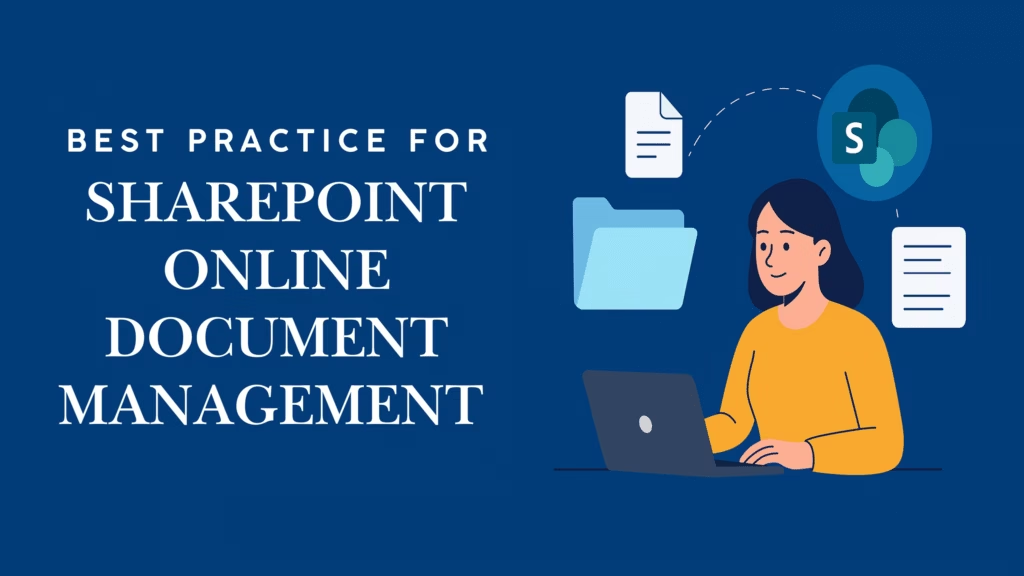When you’re a cloud administrator, it’s impossible to overlook SharePoint Online as a key tool for managing workflows within your organization. It’s one of the most powerful Microsoft 365 applications for organizing sites, libraries, lists, and pages efficiently.
As Microsoft 365 continues to grow rapidly, the number of SharePoint users increases just as quickly. However, in today’s digital environment, simply uploading data to SharePoint is not enough. Organizations need a structured approach to data management to ensure consistency, collaboration, and security.
This guide is designed to help administrators and their teams maintain order, improve collaboration, and enhance data protection within SharePoint Online.
Site Architecture
A Communication Site or Team Site in SharePoint serves as a container for various folders and subfolders. However, it’s essential to manage these structures efficiently using proper tags, clear site names, and a flat folder hierarchy. Avoid creating deeply nested folders, as they make navigation and document retrieval more complex.
A well-designed site architecture not only helps teams and users locate documents quickly but also ensures consistency and organization across the entire workspace.
Seamlessly migrate your data to SharePoint with our expert team—secure, efficient, and hassle-free
- SharePoint On-Premise to Online
- SharePoint to SharePoint Online
- Zero Downtime
Use Document Libraries
While folders are efficient and useful on a local system, the approach changes when working in a cloud-based environment. In SharePoint Online, instead of relying heavily on folders, users can create Document Libraries, a more flexible and powerful way to store and manage files.
Document Libraries provide better control over your data through features like metadata properties, version history, workflows, and permissions.
Key Benefits:
- Easily filter, sort, and search for documents
- Seamlessly supports automation through Power Automate
- Enables better version tracking and sharing capabilities
By using Document Libraries instead of traditional folder structures, you create a more organized, efficient, and collaborative workspace in SharePoint Online.
Meta Data and Naming Convention
Assigning meaningful names to columns such as Department, Project Name, or Document Type, makes searching and filtering in SharePoint more efficient and reliable. Metadata helps users quickly locate the right information without navigating through complex folder structures.
Collaborate with your team to ensure everyone understands how to create, edit, and manage metadata fields. Once this practice becomes part of their daily workflow, SharePoint transforms into a truly intelligent document management system.
Version Controlling
If you’re not familiar with Version History, think of it as your document’s backup timeline. In shared environments, accidental deletions or file overwrites happen frequently. But with SharePoint Online, you can easily track, restore, and recover previous versions of your documents.
Key Benefits:
- Easily restore a previous version of a document
- Maintain audit trails and compliance records
- Identify who modified a document and when
- Enable both major and minor versioning to keep a clear record of document progress
By properly using version control, you ensure your team never loses important data and can always revert to an earlier, verified copy when needed.
Manage Permission
Permissions in SharePoint act as a permit to access company data, but not everyone should have the same level of access. Administrators must carefully assign the right privileges and number of users before granting permissions.
SharePoint provides granular control over who can view, edit, or share documents. If access is given too broadly, it can lead to data breaches or accidental information exposure.
Notable Point:
- Assign permissions to groups rather than individual users
- Grant access based on specific roles and privileges
- Conduct regular permission audits and review access reports
Use Power Automate
Power Automate is a powerful feature in SharePoint that helps administrators instantly track reporting, requests, updates, and approvals. Users can integrate automated workflows for repetitive tasks within their organization using Power Automate.
Key benefits:
- Notify when file is edit, update, and deleted.
- Document Approval request
- Auto archive outdates files.
Apply Retention and Compliance Policy
Over time, organizations accumulate a large volume of data from both internal and external sources. Keeping outdated or irrelevant information can clutter your SharePoint environment, making it harder to find and manage current documents.
Regularly archiving or deleting old data ensures a stress-free SharePoint environment and helps users quickly identify and work with fresh, relevant content.
Training
Without proper training, SharePoint cannot deliver its full potential for managing and controlling organizational data. It’s essential to train team members and periodically update them on their permissions and workflow responsibilities.
Creating short video tutorials, step-by-step guides, and regular practice tasks can gradually improve user performance. Over time, this enhances efficiency, ensures consistent use of SharePoint features, and makes your document management system more effective.
Conclusion
Microsoft has made SharePoint a full-featured platform, but without proper knowledge and usage, many of its best features remain untapped. By following this guide, you can understand the importance of structured folders, metadata usage, version control, and workflow automation within your organization.
Implementing these best practices helps create a secure, efficient, and collaborative document management environment, allowing your team to fully leverage SharePoint Online’s capabilities.
Read More

